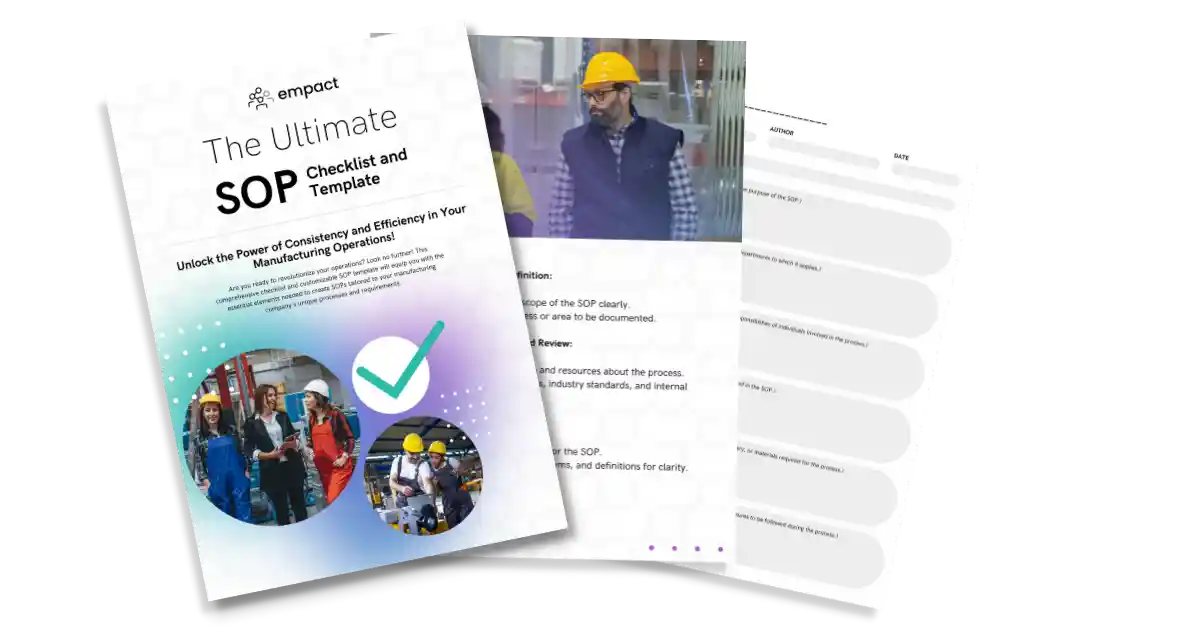The Ultimate SOP Checklist and Template
Designed to help you streamline your complex tasks.
Our SOP Template and Checklist are powerful tools that provide you with a step-by-step guide to develop and implement effective processes. Whether you're a small startup or a large enterprise, this resource will assist you in fostering a positive work environment, enhancing productivity, and driving employee satisfaction.

In business operations, the thread that weaves together efficiency, consistency, and success is often labelled as Standard Operating Procedures, or SOPs. These internal documents act as the guiding principles, providing a roadmap for employees to navigate complex processes seamlessly. In this comprehensive guide, we will delve into the essence of SOPs, exploring their definition, purpose, and the pivotal role they play in shaping the trajectory of successful businesses.
At its core, a Standard Operating Procedure, abbreviated as SOP, is more than a mere document. It serves as the backbone of a company's operational framework, breaking down intricate processes into digestible, step-by-step instructions. The primary goal? To create a standardized, uniform workflow that not only enhances efficiency but also aligns every member of the workforce to a shared way of working.
The Purpose and Benefits of SOPs
Ensuring Consistency and Efficiency
Imagine a business as a well-choreographed dance; each employee performs their steps with precision, contributing to the harmonious rhythm of operations. SOPs act as the choreographer's notes, ensuring every movement is synchronized, eliminating deviations, and resulting in a consistent and efficient performance.
Reducing Errors and Increasing Cost Savings
In the intricate dance of business, errors can lead to costly missteps. SOPs function as a preventive measure, creating a safety net that minimizes the chances of mistakes. By providing a clear playbook, SOPs mitigate the risk of miscommunication and procedural mishaps, ultimately saving businesses both time and money.

Aligning Workforce and Ensuring Compliance
Just as a musical ensemble follows the conductor's lead, a well-guided workforce operates in harmony. SOPs serve as the conductor's baton, directing every member toward a standardized way of working. Moreover, in industries with stringent regulations, SOPs ensure compliance, acting as a shield against potential legal pitfalls.
Enhancing Operational Efficiency and Increasing Profits
Efficiency is the heartbeat of successful businesses. SOPs contribute to operational excellence, streamlining processes and paving the way for increased profits. By fostering a culture of precision and uniformity, SOPs lay the groundwork for continuous improvement and sustained growth.
In the following sections, we will explore the intricacies of crafting effective SOPs, from understanding the template to implementing best practices, overcoming communication challenges, and leveraging digital platforms for optimal reach and impact.
Crafting a SOP Template
Understanding the SOP Document
Before delving into the intricacies of crafting SOPs, it's essential to grasp the concept of the SOP document itself. A standard operating procedure is not merely a set of work instructions; it is a strategic document containing detailed instructions to guide employees through technical and repetitive processes within an organization.
Defining the SOP Template and its Significance
While SOPs serve as the backbone of operational efficiency, SOP templates function as the architectural blueprints. A SOP template is a preformatted document that serves as a starting point for crafting specific SOPs. Why are templates crucial? They ensure consistency across various SOPs, offering a standardized structure, from font styles to spacing, fostering a cohesive and easily navigable repository of procedures.
Importance of SOP Templates in Crisis Management (Inspired by COVID-19)
Recent global events, such as the COVID-19 pandemic, underscore the importance of having SOP templates readily available. In times of crisis, businesses must adapt swiftly and implement new operating procedures to ensure the safety of their workforce. SOP templates serve as invaluable tools, enabling organizations to respond promptly and effectively to unforeseen challenges.
In the subsequent section, we will explore how to build an effective SOP template, providing insights into establishing style and layout, key sections, and drawing inspiration from real-world examples. If you want a good starting point then download our SOP template & checklist using the form below.
How to Build an Effective SOP Template
Establishing Style and Layout for Consistency
Consistency is the cornerstone of effective SOPs, and it begins with the establishment of a uniform style and layout. From font choices to line spacing, building a framework that remains constant across different SOPs is essential. This consistency not only enhances readability but also enables employees to quickly locate the information they need, fostering a culture of clarity and precision.
Key Sections in an SOP Template
A well-crafted SOP template comprises several key sections, each serving a specific purpose in conveying information clearly and comprehensively. These sections include:
Title: Every SOP requires a unique and descriptive title that succinctly outlines the task or process it addresses.
Introduction: Some companies opt to include a brief introduction, serving as a reminder of the organization's mission or the broader context of the SOP.
Scope of SOP: This section elucidates the purpose of the SOP, the specific process it covers, and the reasons for following the enclosed steps—whether related to compliance, safety, or other factors.
Contacts: Identifying the intended audience, listing roles and responsibilities, and providing contact information for coordinating personnel.
Glossary: Inclusion of a glossary becomes crucial when SOPs involve specific language or acronyms, ensuring clarity in communication.
Step-by-step Process: The heart of the SOP, breaking down the procedure into sequential instructions, possibly accompanied by relevant information such as specific equipment used.
Checklists: For some processes, itemized checklists offer a user-friendly alternative, simplifying complex procedures into actionable steps.
SOP Template Overview: Learning From the Georgia Department of Transportation's Example
The Georgia Department of Transportation, with its colossal annual budget and extensive workforce, offers a compelling example of SOP mastery. Within its master SOP, encompassing the intricacies of managing numerous projects simultaneously, the department has created 47 sub-SOPs for specific tasks. This approach, akin to a meticulously crafted playbook, exemplifies how a strict protocol and detailed guides for each task can simplify and streamline the management of large-scale projects.
Drawing inspiration from such real-world examples, organizations can develop SOP templates that align with their unique operational requirements, fostering a culture of precision and efficiency.
In the subsequent sections, we will explore tips for crafting effective SOPs, best practices for rolling out new SOPs, and strategies for overcoming communication challenges. Each facet contributes to the overarching goal of mastering SOPs for unparalleled business success.
Tips for Crafting an Effective SOP
Identifying the Target Audience
The effectiveness of an SOP hinges on its ability to resonate with its audience. Identifying the target audience is the initial step, influencing the level of detail and language used in the SOP. Whether addressing a group with prior experience or newcomers, tailoring the wording and technicality ensures the SOP serves its purpose seamlessly.
Logical Breakdown of Processes
Imagine crafting an SOP as akin to mapping a journey. A logical breakdown of processes involves walking through the entire procedure, meticulously dissecting each step in sequential order. This ensures that no vital information is omitted and that the SOP serves as a comprehensive guide for employees.
Clarity and Conciseness in Language
The cardinal rule of SOP crafting is clarity. Ambiguity is the enemy of effective procedures. To combat this, simplicity in language is key. Utilizing the active voice with command verbs, such as "Clean the machine after every use," ensures instructions are concise, direct, and engage employees effectively.
Employee Surveys for Comprehensive SOPs
Before embarking on SOP creation, conducting employee surveys is a strategic move. This process involves engaging with the workforce to ensure that every step in the procedure is accounted for. Valuable insights from those directly involved in the task contribute to crafting SOPs that align seamlessly with on-the-ground realities.
Developing and Using an SOP Format
Consistency is paramount in SOP creation, and a predetermined format expedites the process. Whether opting for a visual guide, flow chart, bulleted list, or a more formal written report, selecting an SOP format that aligns with the task's nature enhances readability and user-friendliness.
Digital Distribution of SOPs
In the contemporary workplace, leveraging digital tools is paramount. The most effective way to distribute SOPs is through a mobile workplace app, providing every employee with instant access to the document on their mobile device. This ensures real-time updates and facilitates efficient communication.
Utilizing Visuals for Better Comprehension
A picture is worth a thousand words, especially when it comes to complex procedures. Integrating illustrations, flowcharts, or photographs into SOPs enhances user-friendliness and aids in conveying intricate processes in a fast and comprehensible manner.
Conducting Trial Runs for Validation
Testing the efficacy of an SOP is akin to a dress rehearsal before a performance. Subject matter experts, often those regularly performing the task, can run through the steps, ensuring accuracy and completeness. Further validation can be achieved by having someone unfamiliar with the task execute the SOP, revealing any potential gaps or ambiguities.
Implementation and Regular Updates
With a meticulously crafted SOP in hand, the next crucial step is implementation. Informing the entire organization about the new SOP and its location is paramount. Creating an SOP stream on the mobile communication tool allows for real-time feedback, fostering a culture of continuous improvement. Regularly reviewing and updating SOPs ensures they remain reflective of evolving processes within the organization.
Best Practices for Rolling Out New SOPs
Announcing and Communicating SOP Releases
The introduction of a new SOP should not be a clandestine affair. Proactive communication is essential. When a new SOP is ready, broadcasting the information to all relevant employees signals its availability and underscores the expectation for adherence.
Openness to Questions and Feedback
SOPs are living documents that thrive on feedback. Welcoming questions and feedback from employees ensures that the SOP is a practical and accurate guide. This open dialogue fosters a collaborative environment and reinforces the importance of SOPs as dynamic tools for operational success.
Accessibility of SOPs to All Employees
The effectiveness of SOPs relies on accessibility. Avoiding the confinement of SOPs to file drawers, especially in organizations with frontline workforces, involves storing them in the document library of a mobile productivity tool. This ensures that employees can access SOPs on their mobile devices whenever needed.
Continuous Review and Updates for Relevance
Organizations are dynamic entities, and processes evolve over time. A best practice for SOPs is to establish an ongoing review and maintenance plan. Regularly revisiting and updating SOPs guarantees their continued relevance and effectiveness. Outdated SOPs are as detrimental as having no SOPs at all.
In the following sections, we will explore common communication challenges in SOPs and strategies to overcome them. Clear communication is the linchpin of effective SOPs, and understanding and addressing potential stumbling blocks is crucial for successful implementation.
Overcoming Communication Challenges in SOPs
Five Common Challenges and Solutions
Unclear Wording
The success of an SOP hinges on its clarity. If employees are left asking, "What do I do?" after reading the SOP, it defeats its purpose. Using action-oriented language in each step, accompanied by in-house communication team collaboration or hiring a freelance writer versed in SOP style, ensures clarity and effectiveness.
Convoluted Writing and Structuring
An SOP is not a literary masterpiece; it's a practical guide. Avoiding unnecessary complexities ensures SOPs remain to-the-point and easy to read. Being brief, direct, and utilizing visuals and flowcharts contributes to their effectiveness.
Incorrect Information
Accuracy is the bedrock of SOPs. Collaborating closely with employees intimately familiar with the task ensures that every step is outlined correctly. While a freelance writer or communication team might craft the SOP, their partnership with subject matter experts is paramount for accuracy.
Outdated Procedures
Imagine an employee consulting an SOP only to find it outdated. SOPs must evolve with the organization. Regular reviews and updates guarantee that SOPs accurately represent the current state of processes and procedures.
Inaccessibility
Even the most meticulously crafted SOPs are rendered useless if employees can't find them. Placing SOPs in easily accessible locations, whether printed out near relevant stations or, ideally, digitized and stored in the cloud for mobile access, ensures their effectiveness.
Leveraging SOP Employee Apps
Importance of Reaching the Intended Audience
Crafting a well-written SOP is only half the battle. Ensuring it reaches the intended audience is equally crucial. A mobile-first digital workplace serves as an optimal distribution method, acting as an SOP app that guarantees accessibility for every employee.
Advantages of a Mobile-First Digital Workplace
A workplace app offers advantages beyond mere document storage. Its mobile-first design ensures real-time access, allowing employees to retrieve information precisely when needed. Furthermore, digital SOPs can be translated into the reader's preferred language, catering to diverse, multilingual workforces.
Increased Reach and Effectiveness through Digital Platforms
Digital platforms significantly enhance the reach and effectiveness of SOPs. A mobile workforce app reaches everyone in the organization in real-time, ensuring that every employee can access the document on their mobile devices promptly.

Real-time Accessibility and Engagement Tracking
For SOPs to be effective, they need to be accessed and followed. A mobile app with a read receipt feature allows managers to track employee engagement with SOP protocols. This real-time feedback loop ensures that employees are accessing and adhering to the prescribed procedures.
In the subsequent section, we will explore real-world examples of SOPs in action, illustrating their applications in manufacturing, service, administrative environments, and their pivotal role in hiring, training, and routine processes.
SOPs in Action: Real-world Examples
Demonstrating SOPs in Manufacturing, Service, and Administrative Environments
The versatility of SOPs extends across industries, finding application in manufacturing, service, and administrative realms. In manufacturing, SOPs guide machine operations, maintenance, and quality control. In the service industry, they ensure consistent customer interactions, from order processing to issue resolution. In administrative environments, SOPs streamline routine tasks, ensuring uniformity in processes such as document handling and communication.
SOPs in Hiring, Training, and Routine Processes
Hiring Processes
SOPs are not confined to operational procedures; they play a pivotal role in human resources. Crafting SOPs for hiring processes ensures consistency and fairness. From initial candidate screening to interview protocols, SOPs streamline hiring, providing a standardized approach that minimizes biases and ensures adherence to legal requirements.
Training Protocols
In the onboarding process, SOPs serve as indispensable tools for new employees. Clearly outlined training protocols, from orientation procedures to task-specific instructions, empower employees to integrate seamlessly into their roles. SOPs act as a guide, fostering a culture of continuous learning and development.
Routine Processes and Daily Operations
Beyond specific tasks, SOPs contribute to the efficiency of routine processes and daily operations. From managing email correspondence to data entry, SOPs provide a structured approach, ensuring that even mundane tasks are executed with precision and consistency.
In the concluding section, we will revisit the overarching significance of SOPs in driving business success, summarizing key takeaways and offering insights into the future trajectory of SOPs in an ever-evolving business landscape.
Conclusion: Mastering SOPs for Unparalleled Business Success
In modern businesses, where adaptability and precision reign supreme, Standard Operating Procedures emerge as the linchpin for success. From their inception as meticulously crafted documents to their real-world applications in various industries, SOPs guide businesses toward efficiency, consistency, and sustained growth.
Key Takeaways:
-
SOPs as Operational Backbones: SOPs are more than documents; they are the operational backbones that foster consistency, reduce errors, and align the workforce toward shared goals.
-
Crafting Effective SOPs: Crafting effective SOPs involves understanding the target audience, logically breaking down processes, using clear and concise language, and incorporating visuals for better comprehension.
-
Best Practices for SOP Implementation: Best practices for rolling out new SOPs include proactive communication, openness to questions and feedback, accessibility to all employees, and continuous review and updates for relevance.
-
Overcoming Communication Challenges: Recognizing and addressing common communication challenges, such as unclear, convoluted, incorrect, or inaccessible SOPs, is crucial for successful implementation.
-
Leveraging Digital Platforms: The advent of mobile-first digital workplaces offers a transformative approach to SOP distribution, ensuring real-time accessibility, engagement tracking, and increased effectiveness.
-
SOPs in Action: Real-world examples showcase the versatility of SOPs in manufacturing, service, administrative environments, as well as their pivotal role in hiring, training, and routine processes.
As businesses navigate the complexities of a rapidly evolving landscape, the mastery of Standard Operating Procedures remains a beacon of stability and efficiency. Looking forward, the integration of advanced technologies, such as artificial intelligence and machine learning, is poised to further enhance the efficacy of SOPs, paving the way for even greater heights of business success. In this era of innovation, one truth remains constant: mastering SOPs is synonymous with mastering the path to unparalleled business success.